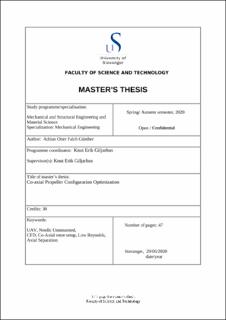| dc.contributor.advisor | Giljarhus, Knut Erik | |
| dc.contributor.author | Günther, Adrian Otter Falch | |
| dc.date.accessioned | 2020-09-25T08:22:06Z | |
| dc.date.available | 2020-09-25T08:22:06Z | |
| dc.date.issued | 2020-06-29 | |
| dc.identifier.uri | https://hdl.handle.net/11250/2679599 | |
| dc.description | Master's thesis in Structural engineering | en_US |
| dc.description.abstract | The majority of research into Co-axial rotor setup involves same-sized propellers. Different-sized propellers have received less attention. The combination of low Reynolds number ( < 500 000) and different-sized propellers even less.
This thesis is looking into co-axial propeller interference with various axial separation and effects concerning different-sized propellers in the co-axial setup, while operating in a small scale. The studies were conducting using Computational Fluid Dynamics simulations in the open-source software OpenFOAM.
Using a larger sized lower propeller than upper propeller lowers the lower propeller efficiency loss by avoiding upper propeller slipstream affecting essential lift areas on the lower propeller.
Using efficiency as a measure of thrust per watts, the highest efficiency gain on lowest propeller was recorded using a combination of a small and large propeller, respectively 28" and 32" diameter propeller. However, the highest overall efficiency was found using both upper and lower propeller as the largest (32") propeller available, because of the increase in efficiency of all propellers when reducing rotational velocity.
The propeller axial separation study showed small variations on efficiency when the lower propeller is operating in the upper propeller's slipstream. This is because of an increased efficiency of upper propeller while the efficiency of lower propeller is decreased, with an increased axial separation. Only at very low axial separation values, the upper propeller had a significant loss of efficiency, which lead to an overall efficiency loss. | en_US |
| dc.language.iso | eng | en_US |
| dc.publisher | University of Stavanger, Norway | en_US |
| dc.relation.ispartofseries | Masteroppgave/UIS-TN-IMBM/2020; | |
| dc.rights | Navngivelse 4.0 Internasjonal | * |
| dc.rights.uri | http://creativecommons.org/licenses/by/4.0/deed.no | * |
| dc.subject | materialteknologi | en_US |
| dc.subject | byggkonstruksjon | en_US |
| dc.title | Co-axial Propeller Configuration Optimization | en_US |
| dc.type | Master thesis | en_US |
| dc.subject.nsi | VDP::Teknologi: 500::Materialteknologi: 520 | en_US |

